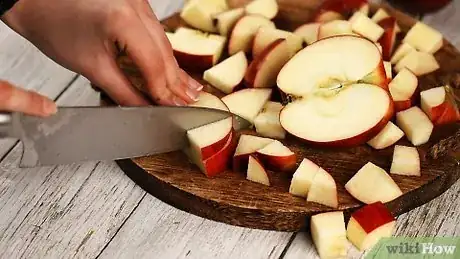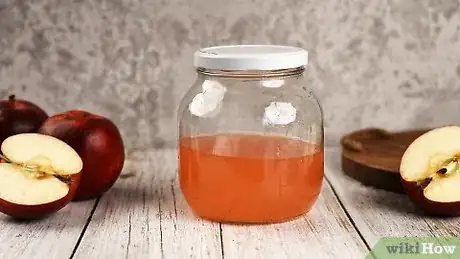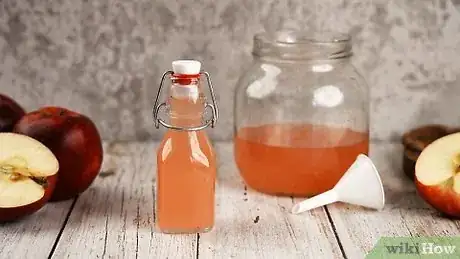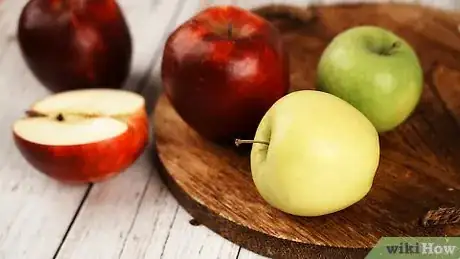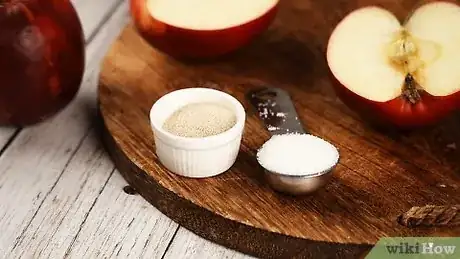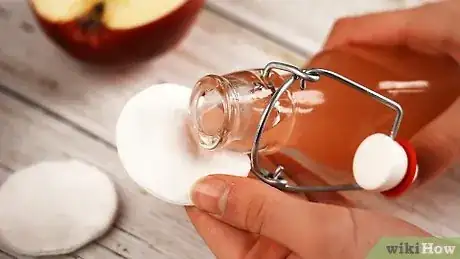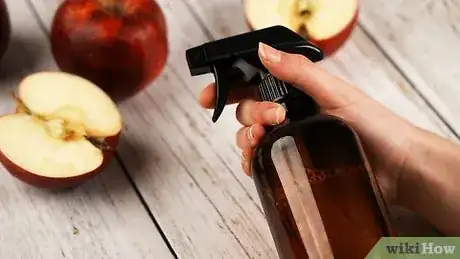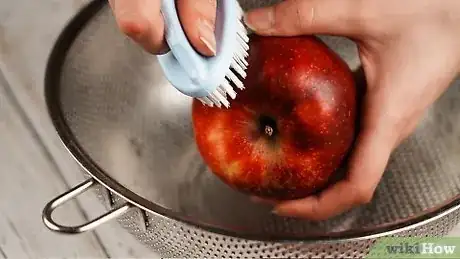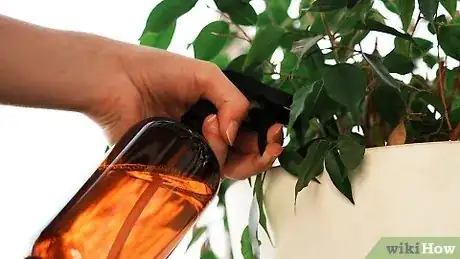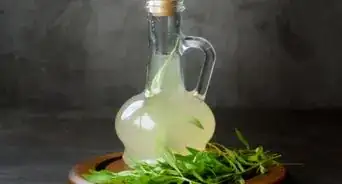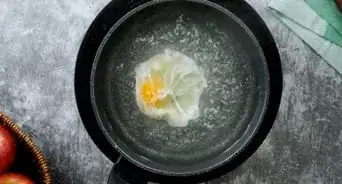This article was co-authored by wikiHow staff writer, Luke Smith, MFA. Luke Smith is a wikiHow Staff Writer. He's worked for literary agents, publishing houses, and with many authors, and his writing has been featured in a number of literary magazines. Now, Luke writes for the content team at wikiHow and hopes to help readers expand both their skillsets and the bounds of their curiosity. Luke earned his MFA from the University of Montana.
There are 8 references cited in this article, which can be found at the bottom of the page.
The wikiHow Culinary Team also followed the article's instructions and verified that they work.
This article has been viewed 871,097 times.
Learn more...
Apple cider vinegar is an all-natural product that has nearly countless uses, whether you're drinking it for health benefits or using it to clean your house. But if you’re already a believer in its many uses, then we don’t have to tell you how expensive it can be on repeated purchase. And if you’re new to the many wonders of apple cider vinegar, then let us introduce you to a handy and simple way to make your own. We’ll walk you through preparing and fermenting your own apple cider vinegar, then fill you in on the many uses it has around your home.
Things You Should Know
- Add 4-5 chopped apples or about 1 cup of apple scraps to a sterilized glass jar and cover them with water.
- Cover the jar with a cheesecloth lid and place it in a warm, dark environment for about 3-4 weeks.
- Filter the solids out of the jar, then let the liquid rest for another 2 weeks before filtering again. Bottle your homemade vinegar in an airtight container.
Ingredients
- Apples
- Water
- Sugar or honey
Steps
Preparing Your Vinegar
-
1Chop 4-5 rinsed apples into roughly 1–2 in (2.5–5.1 cm) pieces. Alternatively, save up your leftover apple cores and peels over a few days to make apple cider vinegar out of 1-1.5 cups (about 120-180 g) of apple scraps.[1]
- If you’re using a jar of a different size, prepare enough apples to fill it ¾ full.[2]
-
2Add the apples to a sterilized 64 oz (~2 L) glass jar, with cool water. Make sure the water covers the tops of the apple chunks. If you need to, place a smaller sterilized jar on top of the apples to weigh them down and ensure they’re completely covered—any apple bits exposed to air inside the jar may rot and ruin your cider.[3]
- For the best results, use filtered water that’s free of any impurities that might affect your cider.
Advertisement -
3Cover the jar with a cheesecloth. As the apples ferment into cider and eventually vinegar, the mixture will still need to be able to breathe. Use a piece of cheesecloth held in place around the mouth of the jar with a rubber band. This will keep any unwanted substances out of the jar, but still let the gasses release during the fermentation process.[4]
-
4Place the jar in a warm, dark place for 3-4 weeks and stir it once a day. Keep the jar out of direct sunlight and in a room that’s about 60–80 °F (16–27 °C).[5] Find somewhere that you can leave the vinegar to ferment for a long time, where it won’t be disturbed unintentionally. Keep it at the bottom or on top of your pantry, in a corner of your kitchen, or anywhere else where it won't be exposed to direct sunlight.
-
5Strain the apples out of the mixture when it smells like vinegar. When the jar’s contents have a pungent scent similar to that of bottled apple cider vinegar, strain the liquid through several layers of cheesecloth or a coffee filter into a clean container to remove any solids.[6]
- If you notice any scum forming on top of the jar, skim it off and discard it.[7]
- Also, taste your cider once every couple days by dipping a spoon into the mixture. Look for a sweet but tangy taste, but wait for more or less time depending on your preference.
-
6Return the liquid to the fermenting jar and let it sit for another 2 weeks. This allows the cider to complete its fermentation and develop that full-bodied tang we’re looking for. Open it up every couple days and give it a stir.[8]
- During this time, you’ll see a solid film form on the surface. This is the vinegar “mother,” which is a solid formed in fermenting liquids that helps fermentation along.[9]
-
7Strain and store the vinegar in a sterilized jar. After 2 weeks, your apple cider vinegar’s all done! Strain off the vinegar mother and pour the vinegar into a sterilized jar. Keep it sealed with a lid and store it in your refrigerator, where it will keep for up to 1 year.[10]
- If you like, let your vinegar ferment for another few days before straining, to let it develop a stronger flavor.
Fermenting Tips
-
1
-
2Optionally, mix in yeast and 2 tbsp (0.5 oz) of sugar. Use 2 tbsp (0.5 oz) of sugar for every 1.5 cups (180 g) of apple scraps, and add yeast according to the instructions on the packaging. Sugar and yeast will both speed up fermentation, and are recommended but not strictly necessary to the process.[13]
- If you opt not to use these, use a sweet apple variety like Fuji apples, and mash your apple pieces before adding them to the jar.[14]
-
3Pasteurize your finished vinegar to preserve it. Boil your new apple cider vinegar in a double boiler to extend its shelf life almost indefinitely.[15] This way, you can store your vinegar in the fridge until it’s completely used, rather than letting it spoil after a single year.
Using Your Apple Cider Vinegar
-
1Cook with apple cider vinegar. The most common (and tasty) use for your new vinegar is cooking with it! Use your homemade apple cider vinegar to pickle vegetables, make a tangy dressing or marinade, add fluff to your baked goods, balance out over salted dishes—the possibilities are basically endless. You can even add some to your pot as you cook eggs for a more consistently boiled or poached breakfast.[16]
-
2Mix apple cider vinegar with liquid dish soap to keep bugs away. Fill a cup about ⅔ full with apple cider vinegar, then add a couple drops of liquid dish soap and give it a mix. Stretch some plastic wrap across the top and secure it with a rubber band. Finally, punch about a dozen holes in the plastic, and voila! A homemade fly trap. Make a few and place them wherever flies or gnats gather.[17]
- Flies and other bugs are attracted to the sweetness of the vinegar, and will get caught in the dish soap mixture.
-
3Use diluted apple cider vinegar as a facial toner. Many people champion apple cider vinegar as a key skincare product that can ease skin conditions like acne or fight signs of aging. To make an apple cider vinegar toner, simply mix 1 part apple cider vinegar with 2 parts water, then dab it sparingly on your skin with a cotton pad once a day.[18]
- If you have particularly sensitive skin, dilute the toner with 3 or even 4 parts water, as needed.
-
4Use diluted apple cider vinegar as a deodorizer. Mix 1 part apple cider vinegar with 1 part water, and pour the mixture into a spray bottle. Use the spray to deodorize things like fabrics, or even apply it to your underarms for use as a deodorant.[19]
-
5Wash your fruits and vegetables with apple cider vinegar. Apple cider vinegar is a fabulous, natural way to remove chemicals and pesticides from your produce. Grab a produce brush (or just use your fingers) and work a dab of apple cider vinegar into the surface of your veggies, then rinse them thoroughly with cool water.[20]
-
6Spritz your pet with diluted apple cider vinegar to keep away fleas. Mix 1 part water and 1 part apple cider vinegar, and funnel the mixture into a spray bottle. Then, from a distance of about 1–2 feet (0.30–0.61 m), mist your pet with 2 or 3 spritzes. Apple cider vinegar is a natural flea and tick repellant, and won’t harm your pet![21]
-
7Kill weeds naturally with apple cider vinegar. Apple cider vinegar is a proven herbicide, so use it to eliminate any pesky, leafy garden intruders. Just spray undiluted apple cider vinegar onto the unwanted weed from about 1 ft (0.30 m) away, and repeat each day as needed.[22]
Community Q&A
-
QuestionHow can I mix apple cider vinegar with water?
 Community AnswerYou should add 2 tablespoons of apple cider vinegar to a glass of warm water.
Community AnswerYou should add 2 tablespoons of apple cider vinegar to a glass of warm water. -
QuestionWhat are the differences between store bought apple cider vinegar and naturally prepared apple cider vinegar?
 Charlie ScheeleCommunity AnswerMost store bought apple cider vinegar is distilled. It does not have the "mother" bacteria, which gives the vinegar its healthful qualities.
Charlie ScheeleCommunity AnswerMost store bought apple cider vinegar is distilled. It does not have the "mother" bacteria, which gives the vinegar its healthful qualities. -
QuestionIs apple cider alcoholic?
 Community AnswerThere are two types of apple cider. One is alcoholic, and the other is not.
Community AnswerThere are two types of apple cider. One is alcoholic, and the other is not.
Warnings
- If you notice green, grey, black, or brownish scum or mold forming on top of your cider vinegar as it ferments, you should dispose of it and start again. It might be a sign of dangerous bacteria that could make you ill.⧼thumbs_response⧽
- Don’t use homemade vinegar for pickling, as this requires an acetic acid level of 5%. It’s difficult to know the exact acetic acid level of homemade vinegar, so it’s best to use store-bought vinegar to be safe.[23]⧼thumbs_response⧽
Things You’ll Need
- Apples
- Knife
- Cutting board
- Glass jar
- Water
- Sugar
- Cheesecloth
- Rubber band
- Wooden or plastic spoon
- Lidded glass jars for storage
References
- ↑ https://closedloopcooking.com/apple-scrap-vinegar
- ↑ https://extension.psu.edu/making-cider-vinegar-at-home
- ↑ https://closedloopcooking.com/apple-scrap-vinegar/
- ↑ https://closedloopcooking.com/apple-scrap-vinegar/
- ↑ https://extension.psu.edu/making-cider-vinegar-at-home
- ↑ https://extension.psu.edu/making-cider-vinegar-at-home
- ↑ https://www.theprairiehomestead.com/2015/02/how-to-make-apple-cider-vinegar.html
- ↑ https://www.rachaelrayshow.com/recipes/homemade-apple-cider-vinegar
- ↑ https://extension.psu.edu/making-cider-vinegar-at-home
- ↑ https://closedloopcooking.com/apple-scrap-vinegar/
- ↑ https://extension.psu.edu/making-cider-vinegar-at-home
- ↑ https://appleforthat.stemilt.com/theres-an-apple-for/cider/
- ↑ https://extension.psu.edu/making-cider-vinegar-at-home
- ↑ https://extension.psu.edu/making-cider-vinegar-at-home
- ↑ https://extension.psu.edu/making-cider-vinegar-at-home
- ↑ https://extension.wvu.edu/food-health/cooking/apple-cider-vinegar-myths-facts
- ↑ https://www.canr.msu.edu/news/how_to_get_rid_of_fruit_flies_in_your_home
- ↑ https://extension.wvu.edu/food-health/cooking/apple-cider-vinegar-myths-facts
- ↑ https://extension.wvu.edu/food-health/cooking/apple-cider-vinegar-myths-facts
- ↑ https://extension.wvu.edu/food-health/cooking/apple-cider-vinegar-myths-facts
- ↑ https://extension.wvu.edu/food-health/cooking/apple-cider-vinegar-myths-facts
- ↑ https://extension.wvu.edu/food-health/cooking/apple-cider-vinegar-myths-facts
- ↑ https://www.theprairiehomestead.com/2015/02/how-to-make-apple-cider-vinegar.html
About This Article
To make apple cider vinegar, first cut some apples into small chunks until you have enough to almost fill a quart-sized (liter-sized) sterilized jar. You can use any kind of apple, and don’t worry about removing the cores, seeds, or stems. Once the jar is nearly full, in a separate bowl, combine 2 tablespoons (25 g) of raw cane sugar and 2 cups (500 mL) of water. Stir until the sugar dissolves. Pour the sugar water into the jar until the apples are completely submerged. Add more water if necessary since the apples can mold if they’re exposed to the air. Now, cover the jar with something breathable, like cheesecloth or a coffee filter, and secure it with a rubber band. As the apples ferment, they'll release gases, and a breathable cover will allow these gases to escape. Store the jar at room temperature in a dark place for 3 weeks, and check on it every day to make sure the apples aren’t exposed or molding. After 3 weeks, strain out the apple chunks. Transfer the liquid back to the jar and cover it again. Finally, store the apple cider vinegar in a dark, room temperature spot for 3 to 4 more weeks. Stir the vinegar every few days until it's ready. To learn how to choose apples to make apple cider vinegar with, keep reading!
